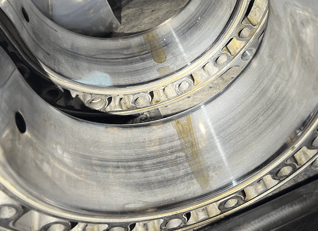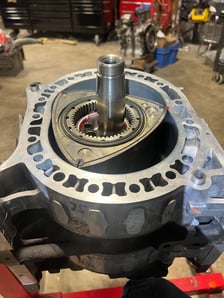 Apex seals are the main wear item that leads to rotor housing failure. As horsepower goes up so does heat and expansion.
Apex seals are the main wear item that leads to rotor housing failure. As horsepower goes up so does heat and expansion.
Sure, the side seals do a lot of work, let's talk about the apex seal and how / why it takes a beating.
Engine failures can be tough to swallow financially, understanding what goes on helps us make better decisions on building a motor that will last.
When the heat is created, it pushes hard on the apex seals to keep the power cycle working as it should. Rotation comes from energy being released as the expansion of fuel, air and ignition all work together. The clearance of the apex seal to the apex seal groove is critical for operation.
As heat is generated, the rotor will absorb that heat (it is cast iron) and expand. The gap between the groove and the thickness of the apex seal is critical. We like 1.5-2.0 thousands or .0381-.0508 mm. Anything tighter and the apex seal would stick under high heat loads. With some motors, the apex groove will become 'V' shaped, then you have the seal 'slamming' back and forth, that will break as time goes on. As with all builds, it important to measure properly and determine if the components are fit for using. Also, choose the apex seal based on expectations for the application.
As the apex seal heats up under load, it starts to bend. That is where details matter, on just about every engine rebuild, we see the rotor housings showing high wear because the apex seal was overheated and tore up the outside edges of the rotor housings.
This is why the right apex seal for the application matters. Rotor housings are always going to take the beating as this heat or overheating continues. For turbo applications, we have to choose an apex seal that is going to take the heat / expansion.
- Hardness
- Bending strength
- Fracture toughness
- Heat resistance
- Density
- Cost
On naturally aspirated engines, the best is going to be made from ceramic material. Lightweight, resistant to heat and they will outlast just about any other apex seal. They are also very good on rotor housing wear, choose wisely. The fact that they are lightweight means that they will stay put under high rpms, for rotary engine builders, this equals consistent pulls to redline over and over again.  Whichever apex seal you choose, always go with new rotor housings, the smooth surface and proper tolerances will equal a quality build. We have seen those whom want to polish older ones, but by the time you get them prepped, the cost / time gets right up to the dollars needed for new ones. Do it right, do it once.
Whichever apex seal you choose, always go with new rotor housings, the smooth surface and proper tolerances will equal a quality build. We have seen those whom want to polish older ones, but by the time you get them prepped, the cost / time gets right up to the dollars needed for new ones. Do it right, do it once.
On performance engines with aftermarket components, tuning / oil injection is critical for longevity. The biggest issue is going to be keeping the apex seals lubricated / cooled on deceleration. For fuel injected motors, making sure that there is sufficient fuel on full throttle closed keep temperatures in check (as well as the occasional flames out the exhaust).
Final note: Have a solid understanding of what happened, make adjustments / measurements of all components to specs and choose the right upgrades for your budget and expectations.
Topics: apex seals, rotor housing failures


